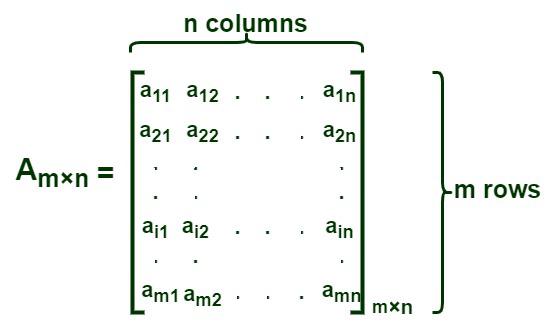
|
|
Singular Matrix: A singular matrix is a square matrix of determinant “0.” i.e., a square matrix A is singular if and only if det A = 0. Inverse of a matrix A is found using the formula A-1 = (adj A) / (det A). Thus, a matrix is called a square matrix if its determinant is zero. Now let us discuss about singular matrix, its properties, and others in detail. Table of Content What is a Singular Matrix?A square matrix is said to be a singular matrix if its determinant is zero and it is not invertible. In a singular matrix, some rows and columns are linearly dependent. As the rows and columns of a singular matrix are linearly dependent, the rank of the matrix will be less than the order of the matrix.  Singular Matrix Definition Singular Matrix Definition
The image given below is an “m × n” matrix that has “m” rows and “n” columns.  We know that the formula to determine the inverse of a matrix is equal to the adjoint of the matrix divided by the determinant of the matrix, i.e., A-1 = (adj A) / |A|. From the definition of a singular matrix, we know that |A| = 0, so its inverse is not defined. Let us consider that A and B are two square matrices of order “n × n” If,
where,
Thus, matrix A is a non-singular matrix. Examples of Singular MatrixVarious examples of singular matrices are:
Properties of a Singular MatrixThe following are the properties of the Singular Matrix:
Differences Between Singular and Non-Singular MatrixDifferences between Singular Matrix and Non-Singular Matrix can be understood using the table given below
Identifying a Singular MatrixFollow the conditions given below to determine whether the given matrix is singular or not.
⇒ If |A|= 0, then the given matrix is singular. ⇒ If |A|≠0, then the given matrix is non-singular. Formula for Determinant of “2 × 2” MatrixIf A = [Tex]\left[\begin{array}{cc} a & b\\ c & d \end{array}\right] [/Tex] is a “2 × 2” matrix, then its determinant is
Formula for Determinant of “3 × 3” MatrixIf A = [Tex]\left[\begin{array}{ccc} a_{1} & a_{2} & a_{3}\\ b_{1} & b_{2} & b_{3}\\ c_{1} & c_{2} & c_{3} \end{array}\right] [/Tex] is a “3 × 3” matrix, then its determinant is
Articles Related to Singular Matrix:Solved Examples on Singular MatrixExample 1: Find the value of k if the matrix given below, is a singular matrix. [Tex]A = \left[\begin{array}{cc} k & -4\\ 5 & 2 \end{array}\right] [/Tex] Solution:
Example 2: Determine the inverse of the matrix given below. [Tex]P = \left[\begin{array}{cc} -3 & 4\\ 6 & -8 \end{array}\right] [/Tex] Solution:
Example 3: Determine whether the given matrix is singular or not. [Tex]A = \left[\begin{array}{ccc} 1 & 0 & -3\\ 0 & 5 & 2\\ -1 & 4 & 0 \end{array}\right] [/Tex] Solution:
Example 4: Find the value of b if the matrix given below, is a singular matrix. [Tex]B = \left[\begin{array}{cc} 9 & b\\ 6 & -2 \end{array}\right] [/Tex] Solution:
FAQs on Singular MatrixDefine a Matrix.
What is a Singular Matrix?
What is the Rank of a Singular Matrix of Order “3 × 3”?
What is the Determinant of a Singular Matrix?
Is a Zero Matrix a Singular Matrix?
What is Rank of a Singular Matrix?
|
||||||||||||||
Reffered: https://www.geeksforgeeks.org
| Class 12 |
Type: | Geek |
Category: | Coding |
Sub Category: | Tutorial |
Uploaded by: | Admin |
Views: | 14 |